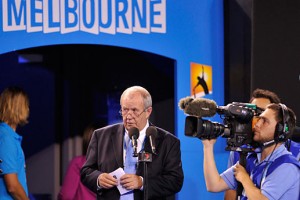At the risk of courting controversy, and in the full awareness that sunstroke may finally have bested my wits, I contend that the coverage of this year’s Australian Open was better than it has been in years. For all that I quite like Mats Wilander, his terrible accident on the eve of the tournament saved Eurosport from growing too tiring in the first week. Mats can grow wearing when consumed immoderately. Barbara Schett can grow wearing in about six seconds flat, but I avoided her. ESPN was no cheesier than usual, as ever festooned with onscreen clutter and a cloying earnestness all its own. The continued absence of John Alexander did Channel 7 no harm (he is now a member of the Australian federal parliament). Joanna Griggs was caught charmingly with her guard down, Jim Courier seemed unusually preoccupied, and Bruce McAveney was oddly diffident.  AO Radio was as ever the pick of the lot, especially when that impish raconteur Craig Willis was on air.
AO Radio was as ever the pick of the lot, especially when that impish raconteur Craig Willis was on air.
Channel 7’s best moment, through being its least mediated, came during the semifinal between Rafael Nadal and Roger Federer, when they crossed to their temporary man in the stands, Patrick Rafter. It was the position usually occupied by Todd Woodbridge or Roger Rasheed. It proved to be a nice change to have Rafter’s comments, although, despite emanating from a former world No.1, two-time major champion, and current Australian Davis Cup captain, the comments were anything but expert. By his own sheepish admission, Rafter doesn’t actually watch much tennis, and he had never before sat court side while Federer and Nadal went at it. It has been eleven years since Rafter retired at the top of the game – he contested the 2001 Masters Cup – and the wonder in his voice made it clear just how far tennis has come. He sounded boyishly shocked, in genuine awe at the quality of the hitting, the fleetness across the surface, at the intensity. Back in the bunker, Courier consoled Hewitt that he still had to plays these guys, and joked that he and Rafter had retired at the right time. The light-heartedness of Rafter’s agreement was tempered by emphatic sincerity. He sounded genuinely relieved.
Darren Cahill, ESPN’s colour man for the match, was ensconced beside Rafter in the camera-pit. It was at this point that he leaned over and remarked that Nadal’s backhand was close to breaking down. Rafter dutifully relayed this to the Australian viewers, his only expert comment of the night, although he would have done better to relay it to Federer. (Presumably Paul Annacone had spotted the issue as well, but sadly the only way for him to get a message on to court was via Uncle Toni. I submit that Federer’s coach tried, but the instructions were sabotaged en route. This explains why Federer kept approaching to the wrong wing.)
The honour for the strangest commentary moment must go to AO Radio, and in particular Richard Evans. Being an online service, AO Radio boasts the dubious advantage of a tighter integration with social media than traditional broadcasters, although Channel 7 ran it close via its digital lobotomy service ‘Fango’. AO Radio listeners were encouraged to send in questions via the iPhone app, which were then answered by the commentators. The rest of us were thus afforded the pleasure of hearing expert tennis broadcasters fielding questions whose answers could be easily found on the internet in a fraction of the time, such as ‘How old is Fernando Verdasco?’. It was rather like asking Jamie Oliver round to whip your kid up a jam sandwich. Mostly the questions were the ne plus ultra of inanity, but occasionally they transcended even that.
I think it may have been during Serena Williams’ upset to Ekaterina Makarova that a blind listener contacted them, although how a blind person might navigate the app was not explored. In spite of his or her visual impairment – which I gathered was total – this listener emphatically declared their love for tennis. Furthermore, in order to share that love, they were undertaking to create a tennis game, in order to accurately simulate the experience of tennis for other blind people. My first, uncharitable, thought was that a blind person’s experience of tennis surely consists of a lot of air swings and the occasional ball to the head. It was not revealed whether the game would involve cards, or computers, or glass beads. Whatever the medium, the project was well underway, apparently, but there were a few details to be worked out, and could the AO Radio announcers please help out. A global listenership was then treated to Richard Evans – a war, political and sports journalist with half a century’s experience – explaining a range of different tennis strokes to someone who will never see them, so that they might integrate them into a game for other people who will never see them, either. I can’t shake the feeling that it was a set up.
